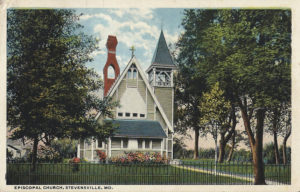History
William Claiborne, who came from England by way of Jamestown, Virginia, established a trading settlement in 1631 at Kent Fort, located at the southernmost end of Kent Island. Claiborne was most concerned that a church also be built so the settlers could continue to worship as they did in their homeland where the Church of England was the established church. In 1632, he brought The Reverend Richard James to the Kent Island shore to conduct worship services at Kent Fort. The earliest mention of the "framing of a church" was in 1636, probably at or near Kent Fort, but no location or description of the building exists.
The struggles between Claiborne, an Anglican, and Lord Baltimore, a Roman Catholic, included several naval battles in the Chesapeake and many bloody skirmishes in a conflict between Maryland and Virginia over who would control Kent Island. In 1658, Maryland gained control of the island. In 1692, the Church of England was officially established in the colony and the counties in Maryland were divided into parishes. An annual levy of forty pounds of tobacco was laid upon all taxables (heads of households). Records show that there were 146 taxables on Kent Island paying a total income of 5,840 pounds of tobacco or a value of roughly $1,000 a year in present day money. Thus, tobacco was the funding source for the construction of the island's first church buildings.
References to a church in 1652 and again in 1712 gave evidence to the existence of Anglican worshippers in the area. Four church buildings, constructed on the same site throughout a period of some two hundred twenty-eight years, were situated at Broad Creek, the Island's first town and were the predecessors to Historic Christ Church. The existing church was built in 1880 when the town center became Stevensville, named after the original land owners, James and Charles Stevens.
The present church is a fine example of Queen Anne style architecture. The unusual chimney style is known as lancet, a style that dates back to the 13th century. The building contains many wooden pegs rather than nails and some of the bricks used in the foundation were from the earlier churches at Broad Creek.
The Church was listed on the National Register of Historic Places in 1979. Queen Anne's County purchased the property in July 2003 after recognizing the historical significance of the building since it at one time housed the oldest continuous Episcopal congregation in the United States. That purchase also included the adjacent parsonage which predates the church by forty years and in 1866 was used to house the Chesapeake Female Institution, a day school for young ladies.
In 2019, the Queen Anne’s County Commissioners selected Friends of Historic Christ Church to assume ownership of the historic church, parish hall and parsonage as a venue for the arts and community events after deciding the County no longer wished to own the property. The agreement for the transfer to Friends of Historic Christ Church was finalized in November 2019.
